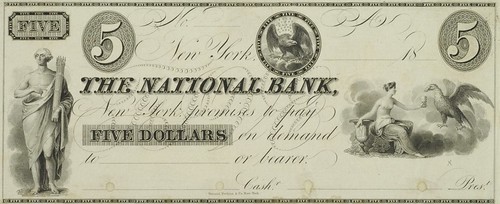
PREV ARTICLE
NEXT ARTICLE
FULL ISSUE
PREV FULL ISSUE
NEW BOOK AND EXHIBIT: MONEY ON PAPER
Alan Stahl, Curator of Numismatics at Princeton University forwarded this press release with details on the upcoming paper money exhibit
-Editor
Exhibit of Paper Money Princeton University, August 30, 2010, to January 2, 2011 Paper money as a form of art might seem the makings of a rather small exhibition, to judge from the modern bills of the United States and Europe. Bank notes, however, have constituted one of the dominant forms of visual communication for the past two centuries, and in many cases can be seen as works of art in their own right. Princeton University's Numismatic Collection is featuring currency worth looking at in the exhibition "Money on Paper: Bank Notes and Related Graphic Arts from the Collections of Vsevolod Onyshkevych and Princeton University," on view in the Leonard L. Milberg Gallery for the Graphic Arts, Firestone Library, Princeton University, August 30, 2010, through January 2, 2011.
One of the highlights of the exhibit will be the first public display of the recently discovered banknote engraving of a grouse by John James Audubon, the great wildlife illustrator's first published work. On display with a sample sheet containing the vignette will be an original watercolor by Audubon, a steel printing plate from The Birds of America, and the Princeton first edition of the elephant folio book open to the page with Audubon's drawing of the pinnated grouse.

Asher B. Durand, one of America's greatest painters, was also a major figure in the development of bank note art in this country. Along with his brother Cyrus, who invented a highly decorative series of anti-counterfeiting devices, he developed a classical, patriotic approach to bank note design that dominated the medium for the first half of the nineteenth century.

A section of the Princeton exhibit will explore the divergence of imagery on the bank notes of northern and southern issuers before and during the Civil War. Collectors of paper money will be especially interested by the complete set, in Extremely Fine condition, of six notes printed by the National Bank Note Company in New York and smuggled into the Confederacy in 1861 for distribution as notes of Montgomery, Alabama, and Richmond, Virginia. The American section of the exhibition ends with the high point of American bank note art, the Educational Series of 1896, designed and engraved by some of the most important illustrators of the day.

The stagnation of American paper money design in the twentieth and twenty-first centuries is put into relief by comparison with some of the beautiful and creative examples of European notes, on loan for the exhibition from the collection of Vsevolod Onyshkevych, Princeton Class of 1983. Alfons Mucha, the popular creator of poster art, designed paper money for Czechoslovakia in the 1920s that epitomizes the glory of art nouveau design. Other important artists of the period, such as Emile Vloors in Belgium and Eliel Saarinen in Finland, put their stamp on the currency of the period. In the second half of the twentieth century, R. D. E. Oxenaar and J. T. G. Drupsteen created a distinctive look for the bank notes of the Netherlands. In the era since the euro imposed a bureaucratic sameness to the currency of most of Europe, Switzerland has kept the innovative look of its paper money with the computer-enhanced colorful notes designed by Jörg Zintzmeyer, while the Faroe Islands have issued a series of simple, evocative notes based on the watercolors of Zacharias Heinesen. A publication entitled Money on Paper, by Princeton's Curator of Numismatics Alan M. Stahl, accompanies the exhibit. It contains a full catalogue of the bank notes on display with color photographs of many of them. There are three additional illustrated essays in the catalogue: Mark Tomasko writing on "Bank Note Engraving in the United States," Francis Musella on "Benjamin Franklin's Nature Printing on Bank Notes," and an edited version of the newsmaking article by Robert Peck and Eric P. Newman entitled "Discovered! The First Engraving of an Audubon Bird." The book is available for $40 from the Friends of Princeton University Library, One Washington Road, Princeton, NJ 08544. Inquiries about ordering can be made to Linda Oliveira at loliveir@princeton.edu or at (609) 258-3155. In a public lecture on Sunday, October 17, at 3 p.m. in McCormick Hall 101, Mark D. Tomasko, a well-known expert on paper money, will speak on "The Art of Bank Note Engraving." The lecture, open to the public without charge, will be followed by a reception in Firestone Library and a curatorial tour of the exhibition. Additional curatorial tours will be held on Sunday, November 22, and Sunday, December 12, both at 3 p.m. "Money on Paper" runs from August 30, 2010, through January 2, 2011, in the Leonard L. Milberg Gallery of Firestone Library, Princeton University. Hours are Monday through Friday, 9 a.m. to 5 p.m., Saturday and Sunday, noon to 5 p.m., closed holidays. Further information can be obtained from Alan Stahl, Curator of Numismatics at astahl@princeton.edu or (609) 258-9127.
Sounds like a great exhibit. And lecture. And reception. And book!
-Editor
Wayne Homren, Editor The Numismatic Bibliomania Society is a non-profit organization promoting numismatic literature. See our web site at coinbooks.org. To submit items for publication in The E-Sylum, write to the Editor at this address: whomren@gmail.com To subscribe go to: https://my.binhost.com/lists/listinfo/esylum All Rights Reserved. NBS Home Page Contact the NBS webmaster 
|
